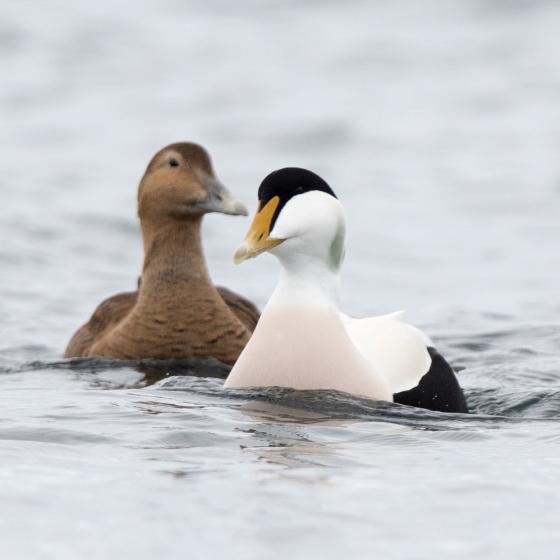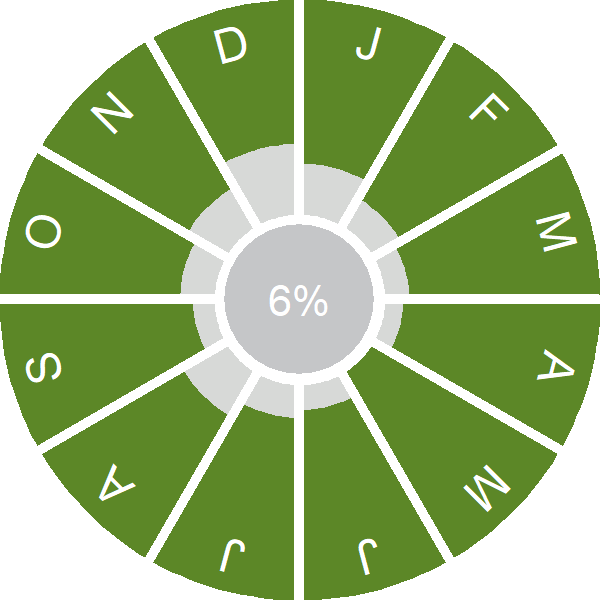Eider

Introduction
This seaduck breeds around the coasts of northern Britain & Ireland, but can be seen further south during the winter months.
British and Irish breeding Eider are at the southern edge of a wider breeding range; while birds breeding further north are migratory, moving thousands of kilometres, our individuals make relatively short movements outside of the breeding season.
Eider feed on Blue Mussels and other molluscs, together with crustaceans and echinoderms. These are taken during dives, typically down to 3 m or so. Individuals favour sheltered feeding and resting sites during the winter, reducing their exposure to the elements.

Key Stats
Identification
Songs and Calls
Song:
Call:
Status and Trends
Conservation Status
Population Change
The extent of breeding range of the Eider is relatively unchanged since the 1968–72 Breeding Atlas, with gains in occupied 10-km squares Wales, Morecambe Bay and the Isle of Man but some losses in western Scotland and Shetland (Balmer et al. 2013). In Shetland, where the birds are believed to be from the faeroensis subspecies, the has been a strong decline from 17,000 individuals in 1977 to 4,627 in 2012 (Heubeck & Mellor 2013). The population trend elsewhere in the UK is unclear.
Distribution
In winter Eiders are found all around the coastline of Britain with the exception of much of the Solway Firth, Cardigan Bay and the Bristol Channel. The greatest concentrations are along the North Sea coast from Shetland to North Yorkshire, and in the northwest in Argyllshire and the Clyde estuary, northern parts of Ireland and Morecambe Bay.
Occupied 10-km squares in UK
or view it on Bird Atlas Mapstore.
or view it on Bird Atlas Mapstore.
European Distribution Map
Distribution Change
Since the 1968–72 Breeding Atlas there have been notable breeding distribution gains in northwest Wales, Morecambe Bay, the Isle of Man, and throughout the north coast of Ireland.
Change in occupied 10-km squares in the UK
or view it on Bird Atlas Mapstore.
or view it on Bird Atlas Mapstore.
Seasonality
Eiders are present throughout the year at suitable coastal locations.
Weekly pattern of occurrence
The graph shows when the species is present in the UK, with taller bars indicating a higher likelihood of encountering the species in appropriate regions and habitats.

Movement
Britain & Ireland movement
Foreign locations of birds ringed or recovered in Britain & Ireland
Dots show the foreign destinations of birds ringed in Britain & Ireland, and the origins of birds ringed overseas that were subsequently recaptured, resighted or found dead in Britain & Ireland. Dot colours indicate the time of year that the species was present at the location.
- Winter (Nov-Feb)
- Spring (Mar-Apr)
- Summer (May-Jul)
- Autumn (Aug-Oct)

European movements
EuroBirdPortal uses birdwatcher's records, such as those logged in BirdTrack to map the flows of birds as they arrive and depart Europe. See maps for this species here.
The Eurasian-African Migration Atlas shows movements of individual birds ringed or recovered in Europe. See maps for this species here.
Biology
Productivity and Nesting
Nesting timing
Egg measurements
Clutch Size
Survival and Longevity
Survival is shown as the proportion of birds surviving from one year to the next and is derived from bird ringing data. It can also be used to estimate how long birds typically live.
View number ringed each year in the Online Ringing Report.
lifespan
Survival of adults
Survival of juveniles
Biometrics
Wing length and body weights are from live birds (source).
Wing length
Body weight
Ring Size
Classification, names and codes
Classification and Codes
- Order: Anseriformes
- Family: Anatidae
- Scientific name: Somateria mollissima
- Authority: Linnaeus, 1758
- BTO 2-letter code: E.
- BTO 5-letter code: EIDER
- Euring code number: 2060
Alternate species names
- Catalan: èider comú
- Czech: kajka morská
- Danish: Ederfugl
- Dutch: Eider
- Estonian: hahk
- Finnish: haahka
- French: Eider à duvet
- Gaelic: Colc
- German: Eiderente
- Hungarian: pehelyréce
- Icelandic: Æðarfugl
- Irish: Éadar
- Italian: Edredone
- Latvian: liela pukpile, gaga
- Lithuanian: paprastoji gaga
- Norwegian: Ærfugl
- Polish: edredon (zwyczajny)
- Portuguese: êider
- Slovak: kajka morská
- Slovenian: gaga
- Spanish: Éider común
- Swedish: ejder
- Welsh: Hwyaden Fwythblu
- English folkname(s): St Cuthbert's Duck
Research
Causes of Change and Solutions
Causes of change
The decline of the Shetland population (faeroensis) has been attributed initially to an oil pollution incident in 1978/79 and high levels of unexplained mortality the following winter; the causes of more recent declines are unknown but may include deterrence measures at aquaculture sites and predation by marine mammals including Killer Whales (Heubeck & Mellor 2013). A study in Northumberland identified changes to adult survival as the main driver of population changes, and suggested that this change was caused by food shortages and had led to recent more widespread declines across northern Europe (Coulson 2010). The same study identified very low survival of ducklings and, although this was not identified as the main driver of population change, the author suggested that increasing duckling survival might be the most likely means to reverse the trend for this species.
Publications (1)
Eider population biology - the Forvie contribution
Author: Baillie, S.R. & Milne, H.
Published: 1998
01.01.98
Papers

